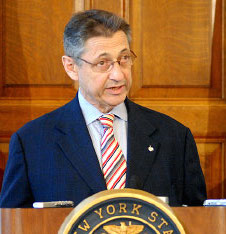
Fingerprinting for food is a fair trade
Nearly one in six residents of New York State now receives food stamps, up from less than one in 10 just a few years ago. New Yorkers now spend food stamps with a value of $5 billion a year, all of it federally funded.
Gov. Cuomo thinks that’s not enough. In his State of the State message, he said he wanted to “increase participation in the food stamp program, remove barriers to participation and eliminate the stigma associated with this program.”
“And,” Cuomo added, “we must stop fingerprinting for food.”
He was referring to a New York City requirement that heads of households applying for food stamps provide a finger image at numerous convenient locations set up for that purpose. City Council Speaker Christine Quinn (D-Manhattan) has also been pushing to end the practice, over the opposition of Mayor Bloomberg.
The mayor can make a strong case for preserving the finger-imaging requirement. More than 60% of food stamp recipients live in the city, and finger-imaging is a proven tool for combatting double-dipping and identity fraud. Over the past 10 years, the procedure has saved taxpayers $32 million, according to city officials. In 2010 alone, it helped detect 1,900 duplicate food stamp recipients for savings estimated at $5.2 million.
It’s not as if New York has not already made a herculean effort to boost food stamp participation. In June 2008, the state and city jointly launched a concerted effort to sign up the working poor and unemployed families for the program, simplifying the application process by offering phone interviews and online applications. Over the next three years, the number of food stamp recipients surged by 67%, from 1.8 million to the current 3 million. A majority of the increase came in New York City, notwithstanding the supposed “stigma” of finger-imaging.
The governor claimed that 30% of potential food stamp recipients are being left out, losing out on $1 billion in benefits. But these numbers grossly exaggerate the situation. The United States Department of Agriculture measures food stamp participation using an “access index,” which indicates that New York State is reaching more than 78% of all eligible households. This is the 17th-highest rate in the nation and the highest participation rate among the 10 most populous states. Growth in the New York City caseload over the same period of time outpaced that of the rest of the state. Applying the same USDA methodology, the New York City participation rate is about 85%.
Most eligible nonparticipants voluntarily opt out because their higher incomes would grant them only a small benefit. They don’t want the hassle. The USDA confirms this by noting in another report that more than 80% of all possible food stamp benefits nationwide are already being issued to those currently on the program . If this figure is to believed — and it is — it simply does not compute that there’s massive unmet need.
In fact, even if the governor were to repeal finger-imaging, the roughly 30% of all food stamp participants who also receive welfare benefits will continue under state law to be subject to the procedure anyway. It was former Gov. Mario Cuomo who first required finger-imaging for single adults on welfare on a pilot basis. The first Gov. Cuomo urged expansion of that effort in his last State of the State address, 18 years ago.
Many individuals are subject to finger-imaging as a condition of employment, and the process is increasingly used in many venues. It’s unnecessary and unwise to abandon a proven method of preventing fraud in a publicly funded entitlement program.






